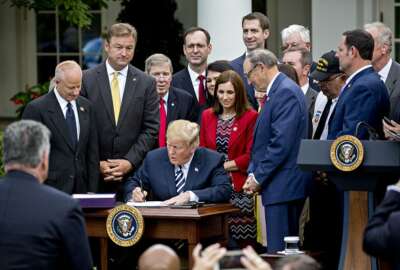

The Department of Veterans Affairs has six months to consolidate disparate community care programs into one, revamped veterans choice program. But lawmakers are...
Both the House and Senate Veterans Affairs Committees are concerned perpetual turnover among the top and middle leadership ranks at the Department of Veterans Affairs is putting the agency’s key priorities, including upcoming changes to VA community care and suicide prevention programs, in jeopardy.
VA has nearly six months to set the parameters for how and where veterans can receive community care in lieu of treatment from the agency. The VA MISSION Act, which President Donald Trump signed into law over the summer, gave the department until June to implement the new veterans choice program.
Members of Congress have their eyes on the criteria, because it’ll ultimately dictate just how freely veterans will be able to tap into community care — and how much the program will cost the department to administer.
The previous legislation, the Veterans Choice, Accountability and Transparency Act of 2014, allowed veterans to visit a community provider if they lived 40 miles away from the closest VA medical facility or if they had been waiting 30 days or longer for VA care.
Lawmakers, in general, didn’t want to use those same standards for the new iteration of the veterans choice program. It’s up to the VA, with the President’s agreement, to set new ones.
But members are concerned the department will eventually decide on parameters that allow veterans to see any doctor they choose at any time.
“If access standard models are expanded to the point — and I don’t think it was congressional intent for this, in fact I know it wasn’t for unfettered choice — we have a big problem. It’s going to cost more money [and] the care isn’t going to be good,” Sen. Jon Tester (D-Mont.), VA committee ranking member, said during a Dec. 19 hearing on the VA MISSION Act. “While you say it’s the President’s decision — and it is, he’s the boss —there better be some good information coming from you and the people who know better that these access standards need to have controls around it.”
Some members said they’ve become increasingly concerned VA won’t meet its deadlines to streamline the seven current, disparate community care programs into one. It also needs to award contracts to third-party administrators and update new IT systems to comply with the new choice program.
VA Secretary Robert Wilkie, who appeared before a joint hearing of both the House and Senate Veterans Affairs Committees last week, insisted MISSION implementation was on firm footing.
The acquisition and awards process, which Wilkie said was delayed before his confirmation as secretary, is back on track.
VA plans to award contracts for third-party administrators to serve three of four U.S. regions by the end of February and a contract for the fourth region in March.
That gives all four regions little time to get ready for the June deadline, House VA Committee Chairman Phil Roe (R-Tenn.) said.
“We’re really pleased with how our contracting has been going,” Steven Lieberman, the new executive in charge of the Veterans Health Administration, told the committees. “We’ve been meeting weekly on this, and we expect it to be completed on schedule.”
VA plans to purchase an off-the-shelf solution, which will auto-adjudicate claims from private providers and should help them get paid more quickly than in the past, Lieberman added.
“We certainty are implementing a number of things to help with timeliness, including timeliness of payments,” he said. “We are going to be requiring, except in rare circumstances that the payments be electronic, which speeds up the claims process.”
Meanwhile, some veterans services organizations have told the VA congressional committees they’re in the dark about the department’s plans for access standards.
“The VSOs, many of them, are complaining that there’s a lack of participation, as per what we said in the MISSION Act,” Rep. Mark Takano (D-Calif.) said. “They should be participating in the development of these access standards. I’m not really satisfied with the answer. I wish we were able to get better insight as to what models you’re considering [and] what the costs are associated with each of these models. That has a lot to do with how much money might be diverted from regular, central VA care.”
Members didn’t get much insight, at least at the public hearing, about VA’s plans for access standards.
But Wilkie said the department has doubled the number of engagements it’s held with veterans service organizations during his tenure. VA is expanding its reach to VSOs that it hasn’t previously had relationships with, he added.
“We have more veterans at the table discussing their issues with us than we have ever had,” Wilkie said. “That mirrors the change in the active-duty, reserve and retiree population that we’ve seen.”
Still, the complaint from VSOs stuck with members of both committees.
“Meeting with them and talking to them is different than listening to them,” Sen. Bernie Sanders (I-Vt.) said. “Can I have your commitment that you will incorporate their ideas and their concerns into the work that you do?”
“Absolutely,” Wilkie said.
Members’ questions quickly turned to a recent report from the Government Accountability Office, which found VA spent $57,000 of its $6 million media budget on suicide prevention outreach. It produced 47 pieces of social media content as of July 2018, compared with 159 pieces during all of 2017.
Lawmakers wanted metrics that detailed the department’s specific goals in reducing veterans suicide, but Wilkie didn’t offer any.
“There is nothing more important, and there is nothing more tragic,” he said. “You have my commitment that as long as I’m privileged to be part of the VA team, that will continue to be the case.”
“I’ve been Congress for six years,” Rep. Ann Kuster (D-N.H.) said. “You are our fifth VA secretary in those six years, so I appreciate your personal commitment. But I have literally heard that five times, and veterans are dying every single day.”
Wilkie reminded lawmakers that it was he who hired a director to lead VA’s suicide prevention office when he became acting secretary. Lieberman said the department is hiring more people to support the new suicide prevention director to fill out the office with more staff.
Both Wilkie and Lieberman said VA would spend every dollar that has been appropriated for suicide prevention. Lieberman said he’s personally reviewing VA’s suicide prevention outreach budget monthly.
“We’ve seen this movie before,” Sen. Richard Blumenthal (D-Conn.) said. “We’ve seen a slew of secretaries who have made commitments and promises, and I think we are, at least speaking for myself, expressing the frustration and impatience that is well-founded in fact because of the turnover in leadership from the top through the middle ranks. … We can’t demand accountability if there is this constant churn and turnover in leadership, which then becomes a failure to spend the money that’s allocated.”
Copyright © 2024 Federal News Network. All rights reserved. This website is not intended for users located within the European Economic Area.
Nicole Ogrysko is a reporter for Federal News Network focusing on the federal workforce and federal pay and benefits.
Follow @nogryskoWFED


